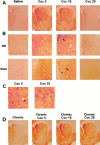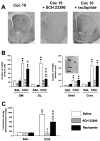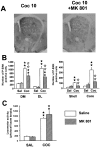Involvement of the extracellular signal-regulated kinase cascade for cocaine-rewarding properties
- PMID: 11102476
- PMCID: PMC6773075
- DOI: 10.1523/JNEUROSCI.20-23-08701.2000
Involvement of the extracellular signal-regulated kinase cascade for cocaine-rewarding properties
Abstract
A central feature of drugs of abuse is to induce gene expression in discrete brain structures that are critically involved in behavioral responses related to addictive processes. Although extracellular signal-regulated kinase (ERK) has been implicated in several neurobiological processes, including neuronal plasticity, its role in drug addiction remains poorly understood. This study was designed to analyze the activation of ERK by cocaine, its involvement in cocaine-induced early and long-term behavioral effects, as well as in gene expression. We show, by immunocytochemistry, that acute cocaine administration activates ERK throughout the striatum, rapidly but transiently. This activation was blocked when SCH 23390 [a specific dopamine (DA)-D1 antagonist] but not raclopride (a DA-D2 antagonist) was injected before cocaine. Glutamate receptors of NMDA subtypes also participated in ERK activation, as shown after injection of the NMDA receptor antagonist MK 801. The systemic injection of SL327, a selective inhibitor of the ERK kinase MEK, before cocaine, abolished the cocaine-induced ERK activation and decreased cocaine-induced hyperlocomotion, indicating a role of this pathway in events underlying early behavioral responses. Moreover, the rewarding effects of cocaine were abolished by SL327 in the place-conditioning paradigm. Because SL327 antagonized cocaine-induced c-fos expression and Elk-1 hyperphosphorylation, we suggest that the ERK intracellular signaling cascade is also involved in the prime burst of gene expression underlying long-term behavioral changes induced by cocaine. Altogether, these results reveal a new mechanism to explain behavioral responses of cocaine related to its addictive properties.
Figures







Similar articles
-
Delta 9-tetrahydrocannabinol-induced MAPK/ERK and Elk-1 activation in vivo depends on dopaminergic transmission.Eur J Neurosci. 2001 Jul;14(2):342-52. doi: 10.1046/j.0953-816x.2001.01652.x. Eur J Neurosci. 2001. PMID: 11553284
-
Dopamine induces a PI3-kinase-independent activation of Akt in striatal neurons: a new route to cAMP response element-binding protein phosphorylation.J Neurosci. 2002 Oct 15;22(20):8911-21. doi: 10.1523/JNEUROSCI.22-20-08911.2002. J Neurosci. 2002. PMID: 12388598 Free PMC article.
-
Dopamine D1 receptor, but not dopamine D2 receptor, is a critical regulator for acute cocaine-enhanced gene expression.Neurol Res. 2009 Feb;31(1):17-22. doi: 10.1179/174313208X332986. Neurol Res. 2009. PMID: 19228458
-
Extracellular signal-regulated protein kinases 1 and 2 activation by addictive drugs: a signal toward pathological adaptation.Biol Psychiatry. 2014 Dec 15;76(12):917-26. doi: 10.1016/j.biopsych.2014.04.005. Epub 2014 Apr 18. Biol Psychiatry. 2014. PMID: 24844603 Review.
-
Drug-induced alterations in the extracellular signal-regulated kinase (ERK) signalling pathway: implications for reinforcement and reinstatement.Cell Mol Neurobiol. 2008 Feb;28(2):157-72. doi: 10.1007/s10571-007-9240-3. Epub 2007 Nov 28. Cell Mol Neurobiol. 2008. PMID: 18041576 Free PMC article. Review.
Cited by
-
Incubation of methamphetamine craving is associated with selective increases in expression of Bdnf and trkb, glutamate receptors, and epigenetic enzymes in cue-activated fos-expressing dorsal striatal neurons.J Neurosci. 2015 May 27;35(21):8232-44. doi: 10.1523/JNEUROSCI.1022-15.2015. J Neurosci. 2015. PMID: 26019338 Free PMC article.
-
Role of Central Amygdala Neuronal Ensembles in Incubation of Nicotine Craving.J Neurosci. 2016 Aug 17;36(33):8612-23. doi: 10.1523/JNEUROSCI.1505-16.2016. J Neurosci. 2016. PMID: 27535909 Free PMC article.
-
Egr-1 induces DARPP-32 expression in striatal medium spiny neurons via a conserved intragenic element.J Neurosci. 2012 May 16;32(20):6808-18. doi: 10.1523/JNEUROSCI.5448-11.2012. J Neurosci. 2012. PMID: 22593050 Free PMC article.
-
Molecular, cellular, and structural mechanisms of cocaine addiction: a key role for microRNAs.Neuropsychopharmacology. 2013 Jan;38(1):198-211. doi: 10.1038/npp.2012.120. Epub 2012 Sep 12. Neuropsychopharmacology. 2013. PMID: 22968819 Free PMC article. Review.
-
Role of nucleus accumbens μ opioid receptors in the effects of morphine on ERK1/2 phosphorylation.Psychopharmacology (Berl). 2016 Aug;233(15-16):2943-54. doi: 10.1007/s00213-016-4340-8. Epub 2016 May 31. Psychopharmacology (Berl). 2016. PMID: 27245230
References
-
- Aizman O, Brismar H, Uhlen P, Zettergren E, Levey AI, Forssberg H, Greengard P, Aperia A. Anatomical and physiological evidence for D1 and D2 dopamine receptor colocalization in neostriatal neurons. Nat Neurosci. 2000;3:226–230. - PubMed
-
- Atkins CM, Selcher JC, Petraitis JJ, Trzaskos JM, Sweatt JD. The MAPK cascade is required for mammalian associative learning. Nat Neurosci. 1998;1:602–609. - PubMed
-
- Berke JD, Hyman SE. Addiction, dopamine, the molecular mechanisms of memory. Neuron. 2000;25:515–532. - PubMed
Publication types
MeSH terms
Substances
LinkOut - more resources
Full Text Sources
Other Literature Sources
Miscellaneous
